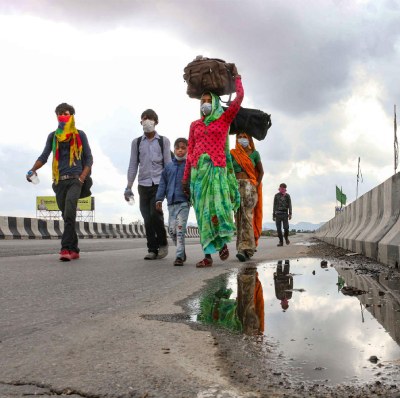
Shramik Special Train Operation: Largest domestic evacuation
- By Divy Vir Patel and Kanhu Charan Behera--
- June 02, 2020
Shramik Special, Migrants, Domestic Evacuation
Background: By 26th of May, India reported 1.45 lakh COVID-19 positive cases; of these 80,578 are active, while 60,706 patients have recovered. An additional 4,172 deaths due to COVID-19 have also taken place. India stands at the 10th position in the world in terms of the number of positive cases. In anticipation, on the 24th March 2020, the GoI ordered a nationwide curfew-like lockdown implying limited geographic movement for everyone and confining everyone to their homes. Under lockdown those without homes faced considerable difficulties leading to wide-spread hunger, impoverishment as incomes dried-up in the informal sector, and left millions of migrant workers unemployed. Graphic images of migrants walking, and cycling 100s of Kms with infants, pregnant women back to their native state have been frequently reported.
Graph 1

Indian Railway and Shramik Special trains: On 1st May 2020 international Labor Day, Indian Railway began operating ‘Shramik Special’ (SS) trains to assist migrant workers, students, and others, who were stranded due to the sudden nationwide lockdown effective in March. These SS trains are operated primarily at the request of the states. For the first 10 days, the SS trains carried 1,200 passengers each and operated as a non-stop service. Since 11th of May, the SS trains have been carrying 1,700 passengers each with three stoppages in the destination states.
Nearly 60% of these trains originated from Gujarat, Maharashtra, and Punjab, while 80% are destined for Uttar Pradesh and Bihar (see Table 1 and Table 2). A surge in the demand for these trains to UP and Bihar has led to congestion and delays in railway operations. Most common destinations in U.P are in the Lucknow-Gorakhpur region, while in Bihar, it is Patna.
By 25th of May 2020, Indian Railway (IR) operated more than 3,060 SS trains ferried over 40,00,000 passengers. While 452 trains are currently in transit, 2,608 have arrived at their destinations. Graph 1 shows the day-wise number of SS trains that have gradually increased to about 250 trains being run daily by the end of May. IR has also converted 5,231 coaches into isolation wards for COVID-19 patients as well.
Table 1 Origin and Destination of Migration

According to The Economic Times, IR officials estimate that ₹80,00,000 is average cost on each of these trains. Table 1 maps the origin and destination of migrant workers who have been using SS trains; this clearly captures key centres from where migrants come from and where they work. Across Maharashtra, Delhi, Karnataka, Haryana and Punjab more than 40% have not returned to their home. Sources said though railways had worked out a ballpark figure of about 40 lakh stranded migrants who needed trains to return to their home states, now it seems the numbers are higher and the national transporter is ready to run 300 to 350 SS trains. With aim to transport 36,00,000 migrants, IR will operationalize 2,600 SS trains in next 10 days.
Challenges for Destination state: As most of SS trains are departing from Red zones, most migrant workers need to be quarantined for minimum 21 days. This is an additional activity that the states of UP, Bihar, Jharkhand, Odisha, Madhya Pradesh and West Bengal must plan. Further, the returning migrant laborer faces unemployment in their native states. State governments are working on skill mapping of returned migrant workers to help with employment and also help with access to welfare schemes. Time will tell the success of these initiatives. As IR transports more migrant workers, Operation ‘Shramik Special Train’ might be the biggest evacuation operation performed till the date.
References:











































































Divy Vir Patel
Kanhu Charan Behera